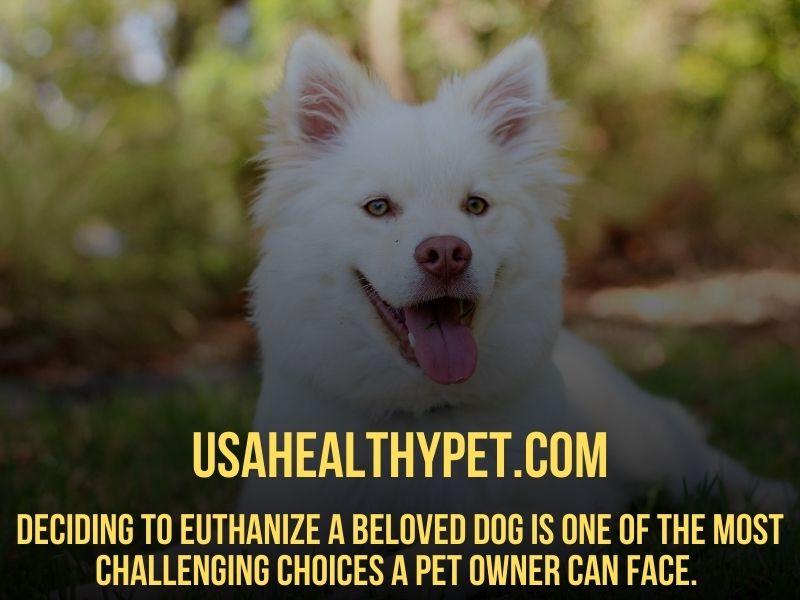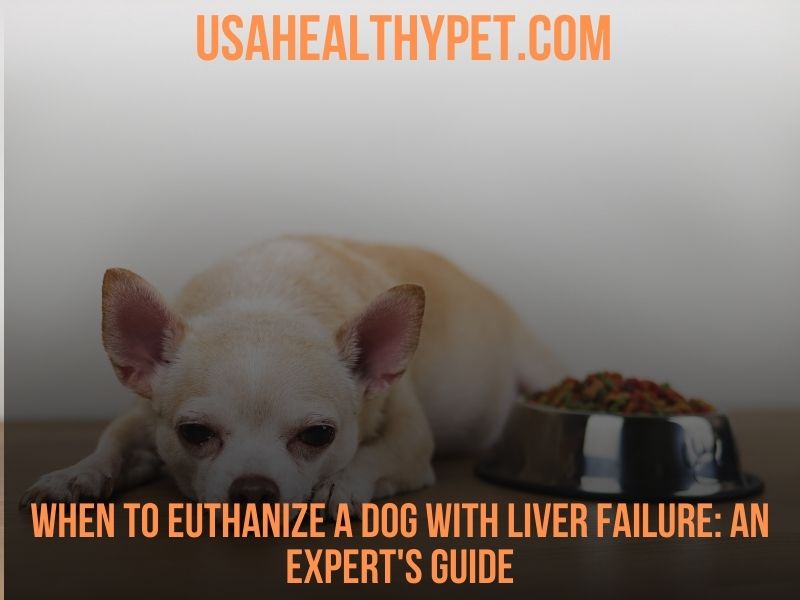Introduction
Deciding to euthanize a beloved dog is one of the most challenging choices a pet owner can face.
When a dog is suffering from liver failure, understanding when it might be time to say goodbye is crucial for ensuring their comfort and dignity in their final days.
This guide provides comprehensive information to help you make an informed and compassionate decision.
Disclaimer: The information provided in this article is based on research and expert opinions. It is not a substitute for professional veterinary advice. Please consult with your veterinarian for guidance specific to your pet’s condition.
- Introduction
- Understanding Liver Failure in Dogs
- Stages of Liver Failure
- Treatment Options for Liver Failure
- Quality of Life Considerations
- Emotional and Ethical Considerations
- Signs That It Might Be Time to Euthanize
- Consulting with Your Veterinarian
- Preparing for Euthanasia
- Expert Opinions on Euthanasia
- The Euthanasia Process
- Supporting Other Pets in the Household
- Resources for Pet Owners
- Conclusion
- FAQs
Understanding Liver Failure in Dogs
What are Liver Disease and Liver Failure?
Liver disease in dogs encompasses a variety of conditions that impair liver function. Liver failure occurs when a dog’s liver can no longer function properly due to severe damage.
Various factors, including toxins, infections, genetic conditions, and prolonged medication use can cause this.
Causes of Liver Failure
Liver failure can stem from numerous causes, such as:
- Ingesting toxic substances
- Chronic infections (e.g., hepatitis)
- Genetic predispositions
- Prolonged use of certain medications
Symptoms and Diagnosis
Common symptoms of liver failure in dogs include jaundice (yellowing of the eyes and gums), vomiting, diarrhea, increased thirst, and lethargy.
Diagnosis typically involves blood tests, ultrasounds, and sometimes biopsies to assess liver function and damage.
Stages of Liver Failure
Early Stage
In the early stages, symptoms might be mild and easily overlooked. Your dog might experience occasional vomiting and a slight loss of appetite.
Middle Stage
As the disease progresses, symptoms become more pronounced. You may notice significant weight loss, persistent vomiting, and increased lethargy.
Late Stage
In the late stages, your dog will likely suffer from severe symptoms, including constant pain, incontinence, and a complete loss of interest in activities they once enjoyed.
Can a dog recover from liver failure?
In some cases, early-stage liver failure can be managed or even reversed with appropriate treatment, but advanced stages are typically irreversible.

Treatment Options for Liver Failure
Medications
Medications can help manage symptoms and slow the progression of liver failure. These may include antibiotics, anti-inflammatory drugs, and supplements to support liver function.
Dietary Changes
A special diet tailored to support liver health can make a significant difference. These diets are typically low in protein and high in antioxidants.
Holistic Approaches
Some pet owners explore holistic treatments, such as acupuncture, herbal supplements, and homeopathic remedies, to complement conventional treatments.
Quality of Life Considerations
Pain and Discomfort
One of the primary concerns is whether your dog is in pain. Chronic pain can drastically reduce their quality of life.
Ability to Enjoy Daily Activities
Consider whether your dog still enjoys daily activities like playing, walking, and interacting with family members.
Appetite and Weight Loss
Significant weight loss and a lack of appetite are indicators that your dog’s condition is deteriorating.
How Long Will My Dog Live with Liver Disease?
The lifespan of a dog with liver disease varies depending on the severity and progression of the condition.
Early detection and treatment can extend their life, while advanced stages often lead to a shorter lifespan.
Dogs with high liver enzymes might live months to a few years, depending on the underlying cause and treatment efficacy.
Emotional and Ethical Considerations
Pet Owner’s Emotional Struggles
It’s natural to struggle with the decision to euthanize a pet. Feelings of guilt, sadness, and uncertainty are common.
Ethical Implications
Consider the ethical aspect of prolonging your dog’s suffering versus the relief euthanasia can provide.
Consulting with a Veterinarian
Your veterinarian can offer invaluable insights and help you weigh the pros and cons of euthanasia based on your dog’s specific condition.
Signs That It Might Be Time to Euthanize
Severe Pain and Suffering
If your dog is in constant pain that cannot be managed effectively, it might be time to consider euthanasia.
Loss of Appetite
A persistent lack of appetite indicates that your dog’s body is shutting down.
Lack of Interest in Life
When your dog no longer shows interest in activities they once loved, it’s a sign that their quality of life is poor.
Incontinence and Other Severe Symptoms
Severe symptoms like incontinence and persistent vomiting are signs that your dog’s condition is worsening.

Consulting with Your Veterinarian
Importance of Professional Guidance
A veterinarian’s guidance is crucial in making an informed decision. They can provide a medical perspective and help assess your dog’s quality of life.
Questions to Ask Your Vet
- What is the prognosis for my dog?
- What are the potential side effects of continued treatment?
- How can we manage my dog’s pain and discomfort?
Understanding the Vet’s Perspective
Veterinarians can offer an objective viewpoint, focusing on the best interests of your pet.
Preparing for Euthanasia
Emotional Preparation
Prepare yourself emotionally for the decision. It’s okay to grieve and feel a range of emotions.
Practical Arrangements
Make practical arrangements for the procedure, including choosing a location and deciding who will be present.
Creating a Peaceful Environment
Ensure that the environment is calm and comforting for your dog during their final moments.
Expert Opinions on Euthanasia
Dr. Jane Smith’s Perspective
Dr. Jane Smith, a renowned veterinarian, emphasizes the importance of quality of life. She states, “When a dog’s daily life is filled with more pain than joy, and medical interventions no longer provide relief, it may be time to consider euthanasia as a compassionate option.”
Dr. Robert Johnson’s Insights
According to Dr. Robert Johnson, “Euthanasia is a deeply personal decision that should be made with the guidance of a trusted veterinarian. Consider your dog’s physical condition, their response to treatment, and their overall happiness.”
Dr. Emily Davis’s Recommendations
Dr. Emily Davis advises pet owners to look for signs of severe discomfort and suffering. “If your dog is experiencing continuous pain, has lost interest in eating, or no longer enjoys their favorite activities, these are strong indicators that euthanasia may be the most humane choice.”
Note: These expert opinions were found with the help of ChatGPT.
The Euthanasia Process
What to Expect
Understanding what will happen during the euthanasia process can help alleviate some of your anxiety.
The Role of Sedation
Sedation ensures that your dog is calm and free from pain before the final injection is administered.
Aftercare Options
Consider your options for aftercare, such as cremation or burial, and how you would like to memorialize your pet.
Coping with Grief After Euthanasia
Grieving Process
Grieving is a personal and unique process. Allow yourself the time and space to mourn.
Seeking Support
Support from friends, family, and pet loss support groups can be incredibly helpful.
Memorializing Your Pet
Finding ways to honor your pet’s memory, such as creating a photo album or planting a tree, can provide comfort.
Supporting Other Pets in the Household
Recognizing Grief in Other Pets
Other pets may also grieve the loss of their companion. Be observant of changes in their behavior.
Helping Them Adjust
Maintain their routine and give them extra attention and affection to help them adjust.
Maintaining Routine
A consistent routine provides a sense of stability and security for surviving pets.
Resources for Pet Owners
Books and Articles
Numerous books and articles can provide further insights and support during this difficult time.
Support Groups
Joining a support group can offer comfort and understanding from others who have faced similar decisions.
Counseling Services
Professional counseling can be beneficial if you’re struggling to cope with the loss of your pet.
Conclusion
Deciding to euthanize a dog with liver failure is an incredibly tough and personal decision.
By understanding the stages of liver failure, evaluating your dog’s quality of life, and consulting with your veterinarian, you can make the most compassionate choice for your beloved pet.
Remember, it’s okay to grieve and seek support during this difficult time.
FAQs
How do I know if my dog is in pain?
Look for signs such as whimpering, restlessness, reluctance to move, and changes in behavior.
How long can a dog live with high liver enzymes?
Dogs with high liver enzymes might live months to a few years, depending on the underlying cause and treatment efficacy.
How long can a dog live with liver failure?
The lifespan of a dog with liver failure varies depending on the stage of the disease and the effectiveness of treatments.
What are the costs associated with euthanasia?
Costs can vary but typically include the procedure itself and any aftercare services like cremation or burial.
How do dogs act when they are about to die?
Dogs nearing the end of life may exhibit symptoms such as extreme lethargy, loss of appetite, incontinence, and seeking isolation. These behaviors indicate that their body is shutting down.
How do I explain euthanasia to my children?
Use simple, honest language to explain that your pet is very sick and that euthanasia is a way to help them stop hurting. Emphasize that it is a compassionate choice made out of love.

Pingback: What to Do When Your Dog's Nail Bends Sideways: Expert Guide
Pingback: Should You Be Concerned If your dog has Yellow Eyes?
Pingback: Best Dog Food for Older Small Dogs with Few Or No Teeth
Pingback: Why Westies Are The Worst Dog: Challenges and Considerations
Pingback: Can Puppies Eat Plantain Chips? Risks and Benefits Explained